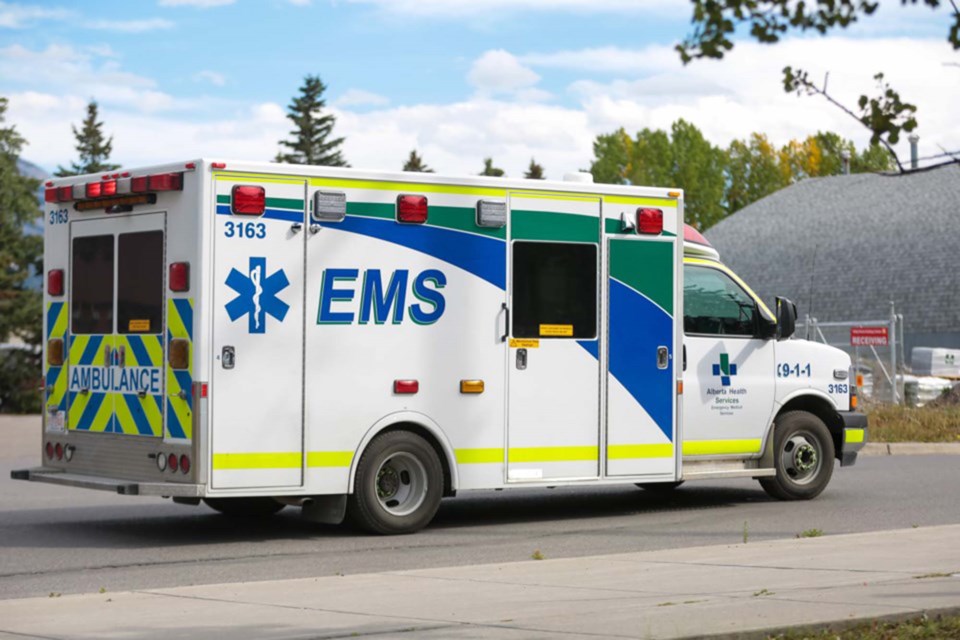Rural municipal leaders are happy the Alberta government is set to review the province's emergency medical system after the announcement Monday of its plans to strike a committee.
Demand for ambulances across Alberta has reached historic highs.
Rural Municipalities of Alberta president Paul McLauchlin said he is pretty excited an advisory committee was struck because it is a recognition there is a problem with emergency response services in the province.
“It's hard, I think, for people to understand quite literally how bad it is. There's a very good chance if I call an ambulance, I won't get one for maybe an hour if there's one even around,” McLauchlin said.
The problem has been building for years, McLauchin said, with the pandemic exacerbating the issue.
Alberta Health Minister Jason Copping said in a press conference last Monday the EMS system is seeing “unprecedented pressures” from COVID-19 and increased calls for services.
Municipal politicians have been sounding the alarm on the challenges faced by the EMS system for months, with both Alberta Municipalities and Rural Municipalities of Alberta passing resolutions to advocate for more support to ambulance services.
Alberta Municipalities (formerly known as the Alberta Urban Municipalities Association) recently passed two resolutions relating to ambulance service in the province, as paramedics across Alberta struggle with intense workloads and psychological burnout.
One resolution will see Alberta Municipalities advocate for a review of the emergency ambulance dispatch system, which has been centralized by Alberta Health Services. The other motion is to advocate for a plan to improve delivery and performance of the ambulance system in the province.
While McLauchlin said he would like to believe the advocacy of both municipal groups brought about the advisory committee, he believes residents writing to their local MLAs about the lack of ambulance services triggered the provincial government's action.
Areas of the province have been battling red alerts, including Cochrane and Airdrie, where no ambulances are available to respond to a call, and municipalities want to see changes to response times.
McLauchlin, who will sit on the new committee, is excited to see the solutions that come forward from the group.
Right now, ambulance services are stretched across the province, with a 30-per-cent increase in call volumes in the past several months. Copping said EMS has hired more than 200 staff, an increase of nine per cent over the past two years, but it is still not enough to respond to all the calls.
At a virtual news conference last Monday, Health Sciences Association of Alberta president Mike Parker, who represents paramedics in the province, said he is cautiously optimistic about the announcement.
“This issue didn’t occur last week. It’s going to take a lot more than a couple of committee meetings to actually have the courage to walk forward and fix the issues that are ongoing, from staffing shortages … to the government recognizing that EMS is a resource that must be funded fully,” Parker said.
For McLauchlin, if better mental-health supports for EMS workers is the only thing that comes out of the committee, he would be happy. The work lifespan for a paramedic has dropped from nine years to five years, and the entire industry is battling high levels of burnout.
“The burnout is just incredible,” McLauchlin said.
Right now, the province operates a borderless EMS system, where the first ambulance that can respond to a call is the one that is sent, through a centralized dispatch system.
But with a lack of resources in the big cities, ambulances from smaller communities get pulled into those cities and then spend the rest of their shifts responding to calls outside of their local communities, according to McLauchlin.
“The borderless system is getting pushed to the limits because the lack of capacity with a borderless system is just creating chaos on availability of resources,” McLauchlin said.
The first meeting for the committee has not yet been scheduled.



